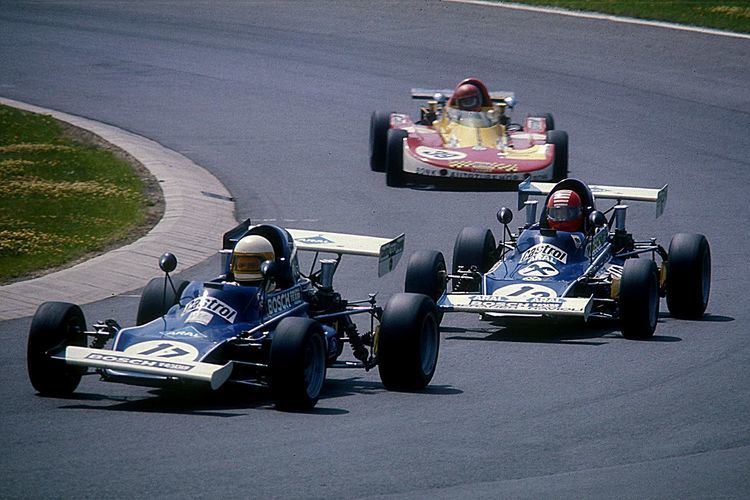 | ||
Formula Super Vee was a type of open-wheel motor created to act as a platform for the promotion of VW products, playing much the same role in the 1970s as formulae such as Formula Renault play today.
Contents
- History
- The original Formula Super Vee series specifications
- USAC Mini Indy professional USA
- References
Initially it was seen as a simple step up from Formula Vee, using the same type 3 air-cooled VW engines, but in 1600cc. However it soon transformed to using the very different and more powerful fuel injected water-cooled engines from the VW Golf/Rabbit.
History
To assist the launch of the new formula Hopen commissioned Gene Beach, an established constructor of Formula Vee cars, to design and build the first Super Vee and put this car on display at the Daytona 24 hour race. Beach was one of the first three constructors of Formula Vees, along with Autodynamics and Formcar. It is therefore appropriate that a Super Vee designed and built by Ray Caldwell’s Autodynamics concern soon joined the Beach Super Vee. This second Super Vee (the Caldwell D-10) was put on display at the New York Auto Show. Other manufacturers soon followed suit, with Formula Vee constructors such as Zink Cars joined by more mainstream firms such as Lola. John Zeitler also built his first cars around the same time as Beach and Caldwell. As a matter of fact, John Zeitler won the very first Super Vee race at Lime Rock Park in 1970. This race was run with the Formula Ford class.
Initially the series allowed 1600cc air-cooled engines of either type 3 (as used in the VW 1500 and 1600) or type 4 (as used in the VW 411, 412 and the VW-Porsche 914/4 sports car), however at a late stage VW had a change of heart and decided that the type 4 engines would be a better option. The type 4 engine is without doubt a better engine. However, this motor was never produced in a 1600cc version so VW decided to produce a "special" 1600cc version through their industrial engines division (the 127V unit), with smaller pistons and barrels, which reduced the capacity to 1600cc.
As with any formula, Formula Super Vee progressed through a number of changes during its life. Initially, for example, the cars ran without wings and used drum brakes at the rear. Later the regulations allowed the use of 8-inch rear wheels, rear disc brakes and 34 mm exhaust valves (1973) and then rear wings (1975). Since slick tyres had yet to be introduced into racing, the cars ran with treaded racing tyres, such as the Firestone "No-DOT", but later moved onto slicks.
The original regulations specified a non-Hewland gearbox and cars ran with fixed ratio VW boxes. In Europe a company called Metso began building Hewland-like boxes which provided the ability to change ratios to suit each circuit and exploited the wording of the regulations, which had simply banned Hewland boxes rather than explicitly specifying the fixed ratio VW box. Once the cars started to use Metso boxes the regulations were changed and Hewland Gearboxes were also allowed. This change, combined with start money being offered by Hewland to drivers using its products, effectively put Metso out of business, although the company did build boxes for other formula cars such as Formula Fords.
Much later, engine regulations were also opened up, allowing fuel injected water-cooled engines from the VW Golf (or Rabbit as it is known in North America). The water-cooled engines inevitably replaced the air-cooled, which were rendered uncompetitive, and many air-cooled cars were converted to accept the water-cooled engine. Some constructors, such as Lola, offered "conversion kits" which allowed the fitment of the Golf/Rabbit engine to earlier air-cooled chassis. The SCCA in the USA did allow 1700cc air-cooled engines towards the end of the air-cooled period, to remain competitive while the water-cooled cars joined the grid.
Ultimately the most developed version of Super Vee was to be found in the USA, since they continued with a Super Vee series years after the formula had died away elsewhere. Indeed, by late 70s Super Vee in the USA had become the feeder formula for Indy cars, referred to as the "Mini-Indy" series. This series was run in conjunction with the much older VW-Bosch "Gold Cup" for Super V. This series lasted until 1990 and, unlike the oval track USAC Mini Indy Series, was a road racing series. Each series crowned its own champion each year. In the late 70s the Ron Tauranac designed the Ralt RT1 and RT5, based on his Formula 3 designs, had a virtual monopoly in the USA series.
